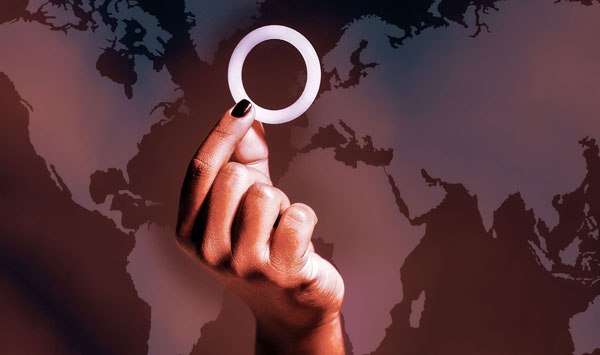
Africa is bringing a new weapon to the war on HIV and Aids, according to health officials. It comes in the form of a rubber and silicone ring being made available to women and girls.
SPECIAL REPORT | BIRD AGENCY | A number of African nations are boldly embracing a game-changing approach to the fight against new HIV transmissions — a vaginal ring.
Thee innovative ring, developed by International Partnerships for Microbicides, is made from a blend of rubber and silicone. By placing the power of prevention directly in the hands of women, the rings could revolutionise the battle against new HIV infections, particularly when used together with other methods of prevention.
“Most of the current HIV prevention methods are male controlled compelling women into negotiating for their use and application,” said Patriciah Jeckoniah, a Kenya-based technical advisor on HIV prevention policy.
Jeckoniah explained that women need more discrete methods of prevention, a gap that vaginal rings bridges. The rings slowly release dapivirine, an antiretroviral drug, over a span of 28 to 30 days before needing replacement.
Kenya is about to launch a major trial of the rings, according to the country’s Ministry of Health.
According to the ministry, the country is embarking on a 5-year study across six facilities in Kisumu, Nairobi, and Mombasa to assess their efficacy.
“In the face of reduced funding in the health sector, vaginal rings offer a preventive solution. Investing a dollar can save fourteen,” said Patrick Amoth, Acting Director General at the Ministry of Health.
Amoth also pointed out that the innovative rings have the potential to address the disproportionately high transmission rates among women and girls.
The latest UNAIDS statistics estimate that between 1 million and 1.7 million individuals contracted HIV in 2022.
While globally, 46% of these new infections affected women and girls, in sub-Saharan Africa women and girls accounted for 63% of nearly 700,000 new infections.
As Kenya moves forward with its study, a pathway towards nationwide adoption and rollout of vaginal rings is gradually taking shape across the continent.
Notably, Zimbabwe and South Africa have already taken the lead. South Africa’s medicines regulator, SAHPRA, granted approval for the rings in March 2022, after Zimbabwe’s approved and rolled them out a year earlier.
Other nations such as Uganda, Zambia, and Malawi have also given their approval for the use of vaginal rings.
Further rollouts are anticipated, after IPM submitted regulatory applications in over a dozen sub-Saharan African countries, spanning Kenya, South Africa, Uganda, Tanzania, Malawi, Zambia, Zimbabwe, Eswatini, Lesotho, Namibia, Rwanda, and Botswana.
Experts emphasise the potential for monumental impact of the rings, provided adoption is widespread.
“With rings even the stigma associated with women who request for prevention methods will have been eliminated,” Jeckoniah explains.
Already, preliminary data from the studies underscores the potential efficacy. A recent mathematical model for South Africa’s HIV epidemic focused on Thembisa reveals a decline in new HIV infections in 2022, with the decline partially attributed to the adoption of vaginal rings, while a groundbreaking 2023 study investigating the efficacy of dapivirine vaginal rings compared to oral PrEP in preventing HIV revealed even more positive findings, with a key indicator being the continued use of the rings.
Focusing on young Zimbabwean women aged 18 to 25, the research showed that among 1000 women studied, 86% used the ring during the second month, a higher adherence rate compared to around 76% for oral PrEP.
“In month four, 64% of young women were still using the ring, compared to 59% of young women who opted for PrEP pills,” beintheknow.org wrote of the findings.
However, studies conducted elsewhere have placed the effectiveness of the ring as low as 27% and no high-income nation has yet licensed the ring. In December 2021, the Food and Drug Administration (FDA) advised the ring’s developer that it would be unlikely to give approval to the ring in the United States because of its low efficacy.
Guidelines will thus be needed to inform women of the efficacy of using the vaginal ring alone or in combination with other HIV prevention methods like oral PrEP.
More superior HIV prevention drugs are already on the horizon, with South Africa on track to manufacture injectable cabotegravir, a two-monthly jab that can almost eliminate women’s chances of contracting HIV.
UNAIDS seeks to have 95% of people at risk of HIV infection being able use appropriate, prioritised, person-centred and effective combination prevention options, by 2025.
*****
SOURCE: bird story agency
 The Independent Uganda: You get the Truth we Pay the Price
The Independent Uganda: You get the Truth we Pay the Price



